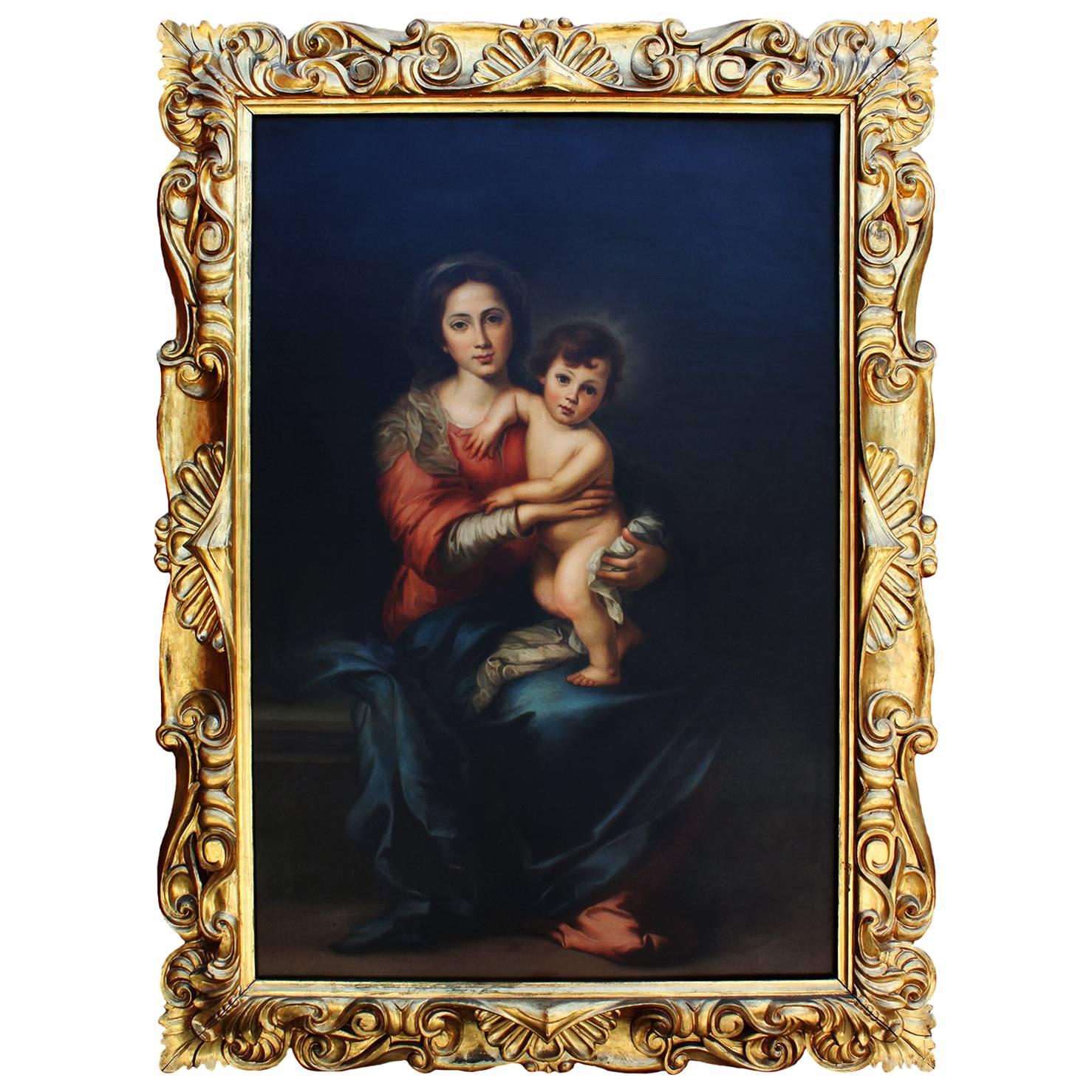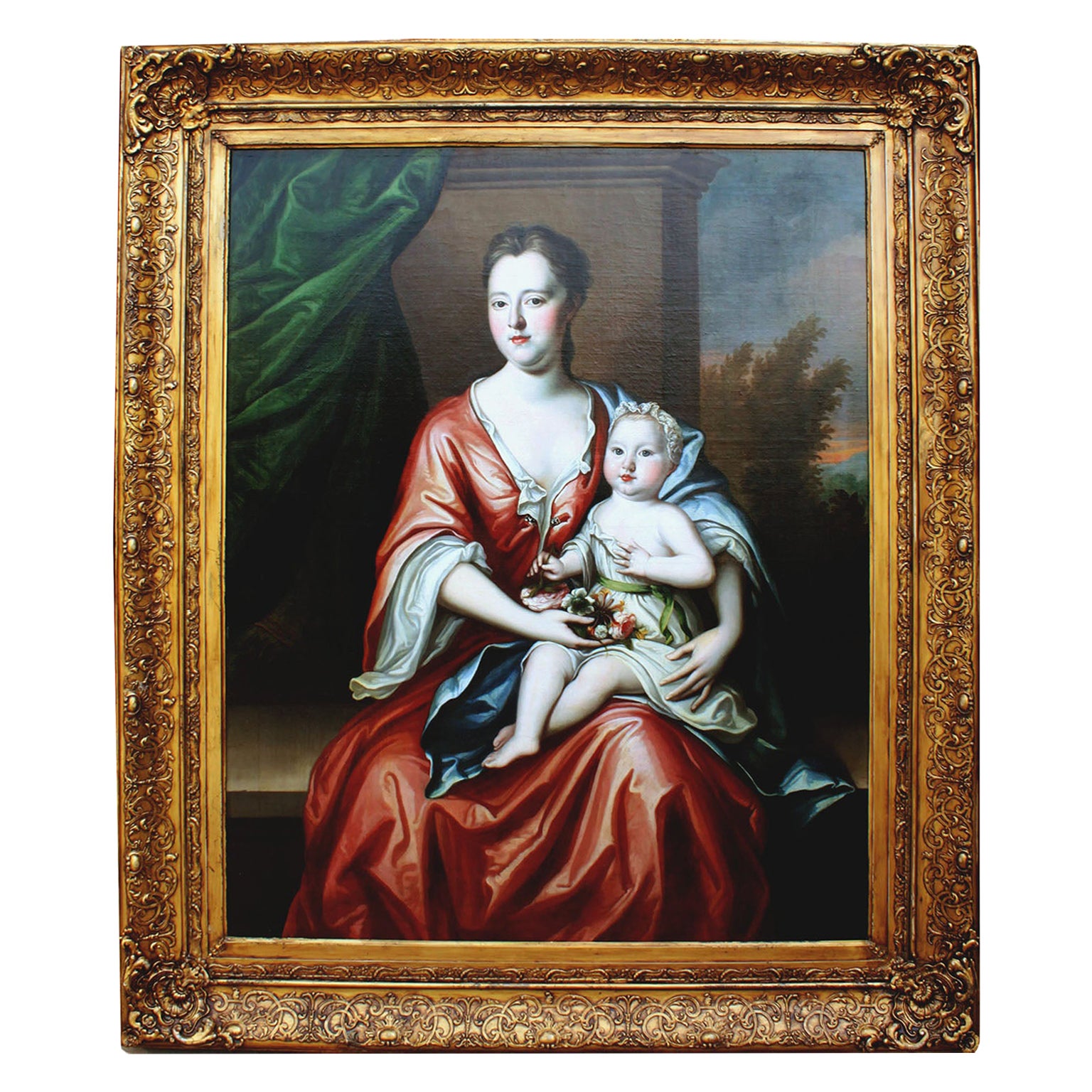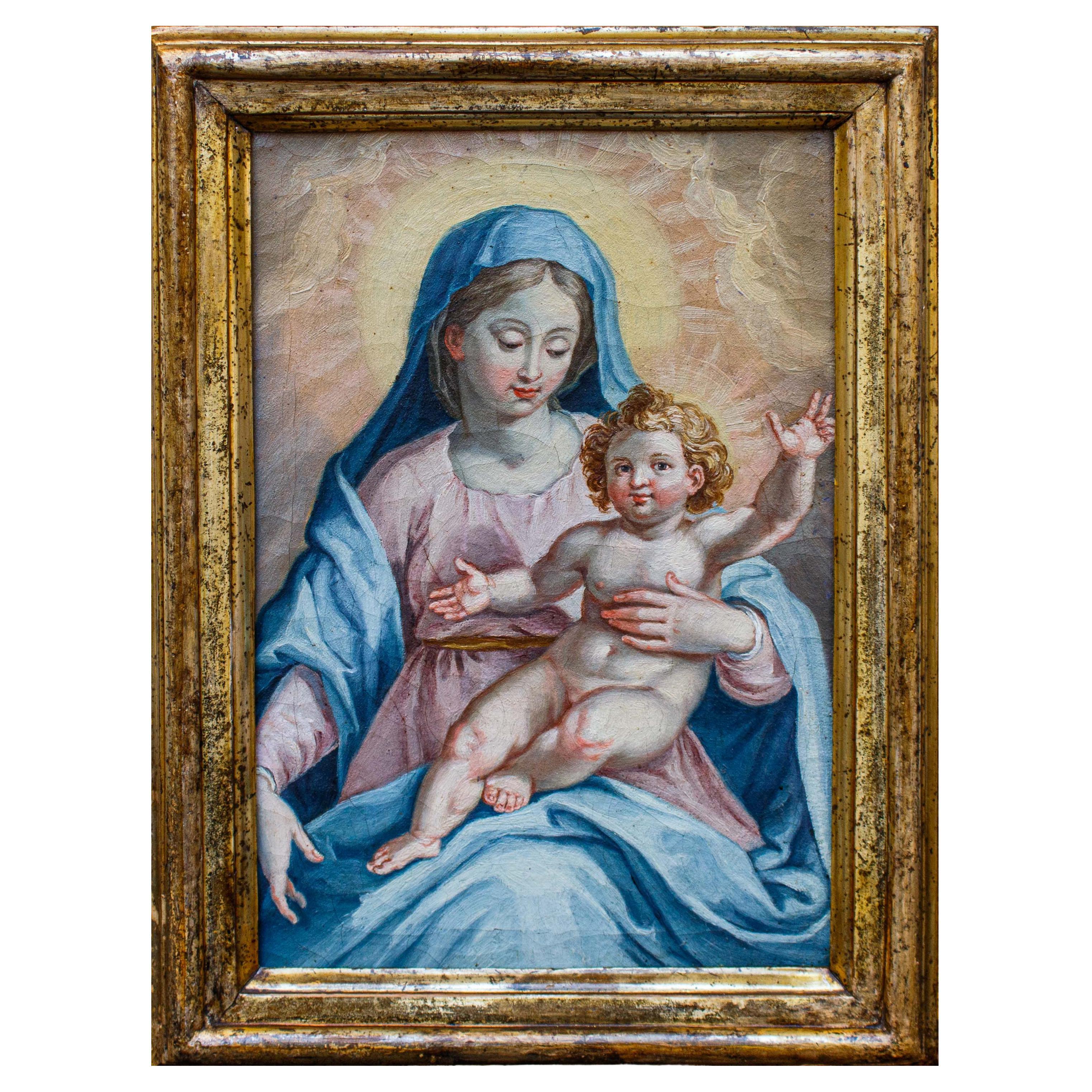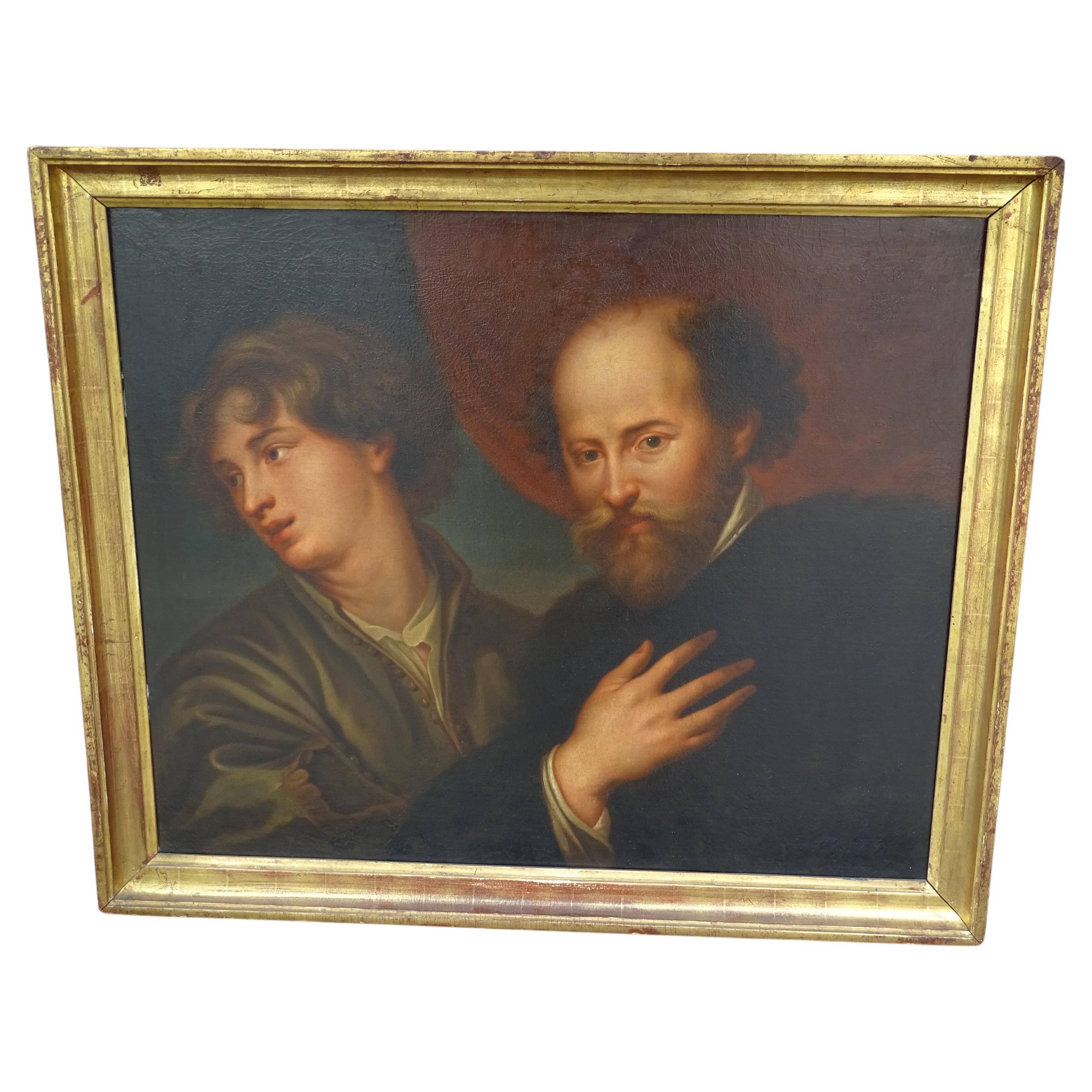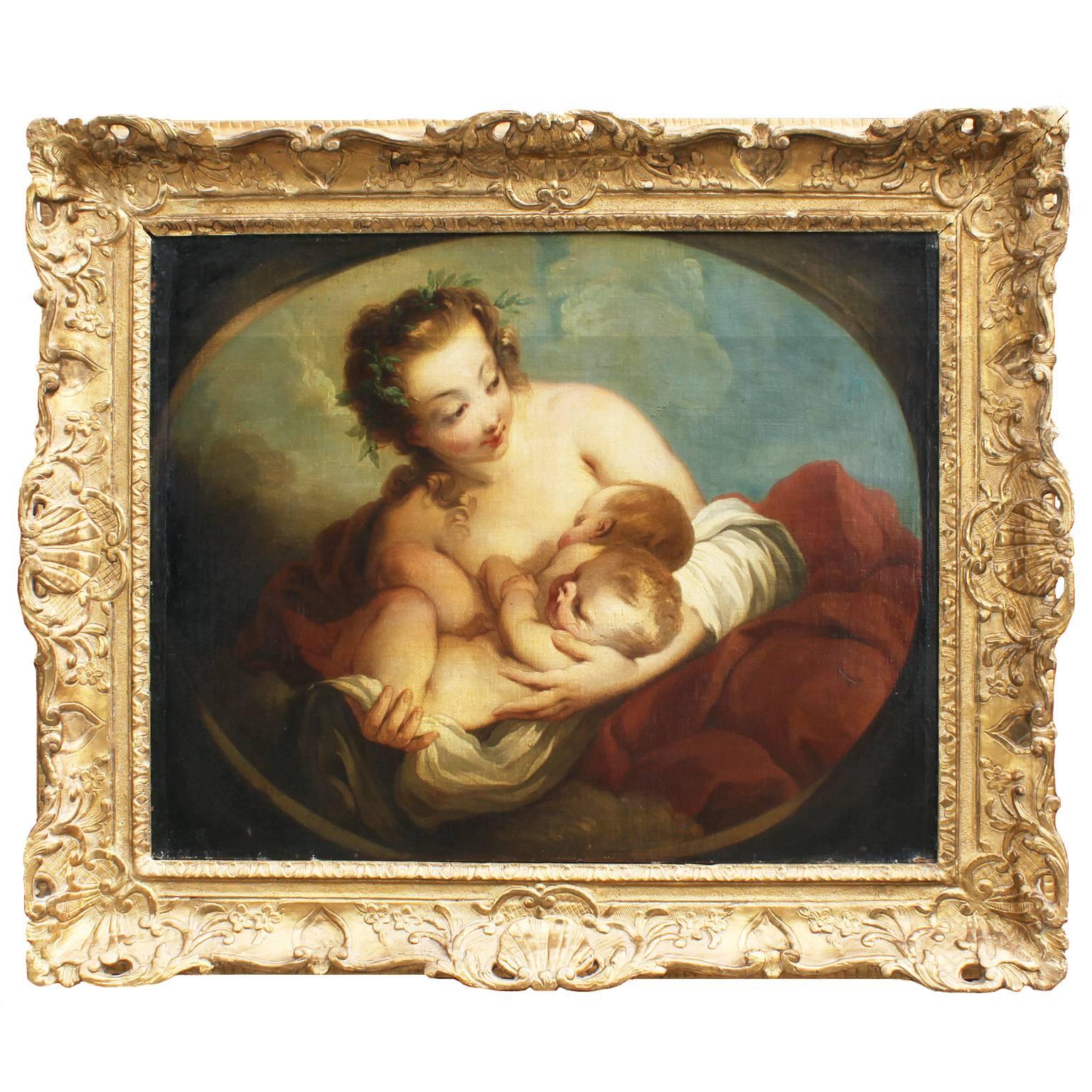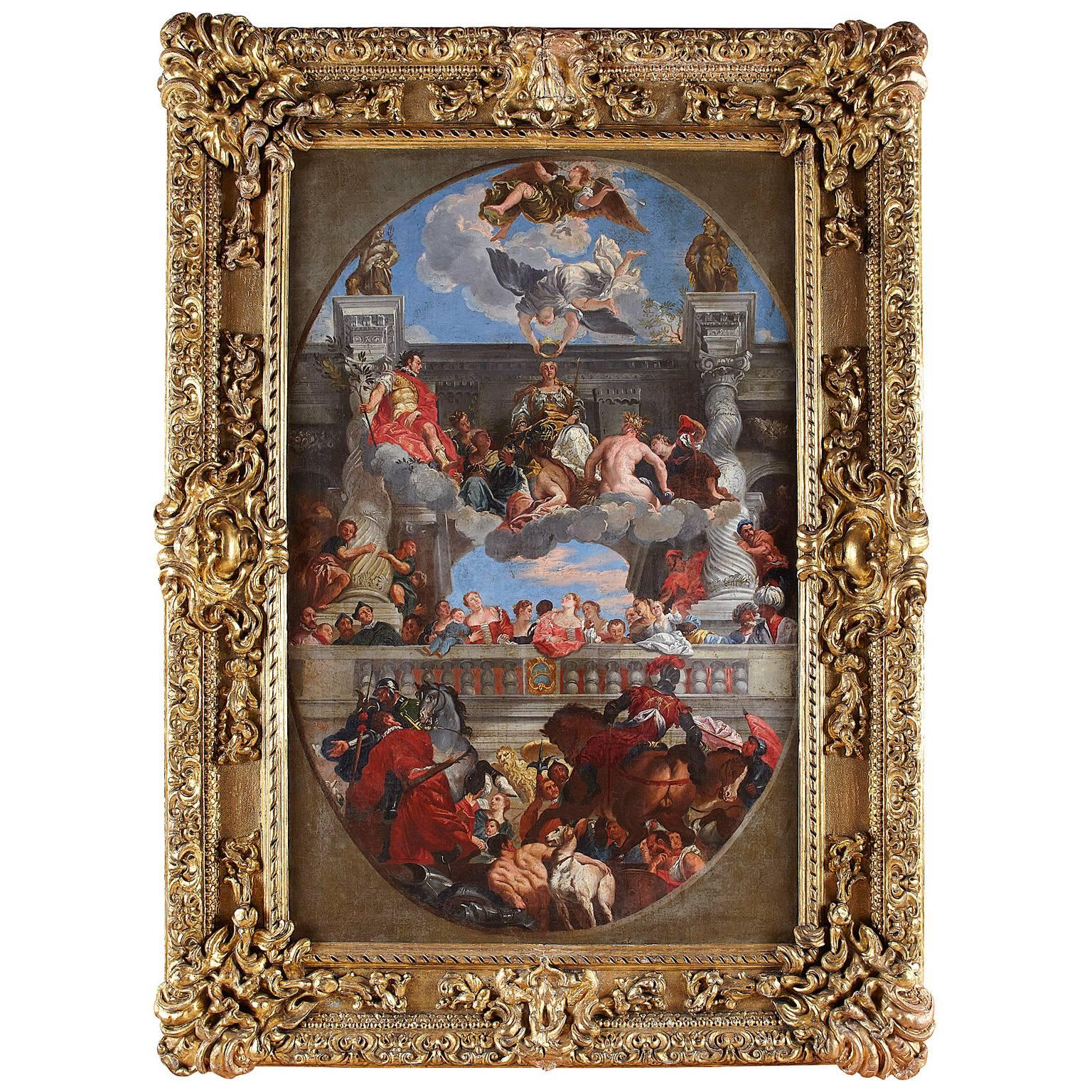Items Similar to Italian 18th Century Oil on Canvas "Madonna and Child" after Giovanni Lanfranco
Want more images or videos?
Request additional images or videos from the seller
1 of 10
Italian 18th Century Oil on Canvas "Madonna and Child" after Giovanni Lanfranco
About the Item
A very fine Italian 18th century oil on canvas "Madonna and Child" after Giovanni Lanfranco (Italian, 1582-1647). The young Virgin Mary attending to a joyful baby Jesus laying down in front of her with an elder man praying to the side, all within an ornate gilt wood carved frame, circa 1780.
Giovanni Lanfranco was a Baroque style artist based in Rome, Italy. He studied under Agostino Carracci and was inspired by Correggio's. His works include frescoes in the Sala Regia in the papal Palazzo del Quirinale. dome of San Andrea della Valle in Rome and the Cappella del Tesoro's cupola in Naples Cathedral among many others.
Canvas height: 37 (94 cm)
Canvas width: 44 1/4 inches (112.4 cm)
Fram height: 44 1/4 inches (112.4 cm)
Frame width: 51 3/8 inches (131.4 cm)
Depth: 3 inches (7.6 cm)
- Similar to:Giovanni Lanfranco (Artist)
- Dimensions:Height: 44.25 in (112.4 cm)Width: 51.38 in (130.51 cm)Depth: 3 in (7.62 cm)
- Style:Baroque (In the Style Of)
- Materials and Techniques:
- Place of Origin:
- Period:
- Date of Manufacture:circa 1780
- Condition:Repaired: Relined, touch ups and some old restorations. Wear consistent with age and use. Minor losses. Minor fading. A really beautiful painting. The canvas has been relined. There restorations to baby foot, Madonna's hands, shawl and other small in-paint touch ups and age craqueleure throughout canvas. In antique but stable condition.
- Seller Location:Los Angeles, CA
- Reference Number:
About the Seller
5.0
Vetted Seller
These experienced sellers undergo a comprehensive evaluation by our team of in-house experts.
Established in 1982
1stDibs seller since 2016
114 sales on 1stDibs
Typical response time: <1 hour
- ShippingRetrieving quote...Ships From: Los Angeles, CA
- Return PolicyThis item cannot be returned.
More From This SellerView All
- Attributed to Giorgio Lucchesi, Oil on Canvas "Madonna & Child" After MurilloBy Bartolomé Esteban MurilloLocated in Los Angeles, CAAttributed to Giorgio Lucchesi (1855-1941) A large and impressive early 20th century oil on canvas "Madonna and Child" after Bartolomé Esteban Murillo...Category
Vintage 1910s Italian Baroque Paintings
MaterialsCanvas, Giltwood
- 18th Century Oil on Canvas Mother & Child Attr Michael DahlBy Michael DahlLocated in Los Angeles, CAA very fine and large 18th century oil on canvas titled "Mother and Child" (Probably members of The Swedish Royal Family). Attributed to Michael Dahl (Swe...Category
Antique 18th Century Swedish Baroque Paintings
MaterialsGesso, Canvas, Wood
- French 18th Century Oil on Canvas Mother and Twin Babies Fecundity after LemoyneBy François LemoyneLocated in Los Angeles, CAA very fine French 18th century oil on canvas "Fecundity" After Francois Lemoyne (French, 1688-1737) Depicting a young mother holding her twin her infant babies on her arms, within a...Category
Antique Early 1800s French Louis XV Paintings
MaterialsCanvas, Giltwood
- 18th-19th Century Oil on Canvas "The Triumph of Venice" After Paolo VeroneseBy Paolo VeroneseLocated in Los Angeles, CAA very fine and Large Italian 18th-19th century oval-shaped oil on canvas titled "The Triumph of Venice" After the original work by Paolo Veronese (Venice, 1528-1588). The original of this painting hangs in the Palazzo Ducale, Venice. The 'Ricci' coloration suggests a late 17th-early 18th century date. In 1715 Charles de la Fosse advised Ricci to paint only "Veroneses and no more Riccis", Venice, circa 1800. Measures: Height: 45 1/4 inches (115 cm). Width: 29 inches (73.7 cm). Frame height: 58 1/4 inches (147.9 cm). Frame width: 43 1/4 inches (109.9 cm). Frame depth: 5 1/4 (13.3 cm). Provenance: Royal Academy of Scotland. Paolo Veronese (Born 1528, Verona, Republic of Venice - died April 9, 1588, Venice) was an Italian painter of the Renaissance in Venice, famous for paintings such as The Wedding at...Category
Antique Early 1800s Italian Renaissance Paintings
MaterialsWood, Gesso, Canvas
- French 18th-19th Century Oil on Canvas Portrait of Lady, after Jean-Marc NattierBy Jean-Marc NattierLocated in Los Angeles, CAA very fine French 18th-19th century oil on canvas portrait of a posing lady with flowers, after Jean-Marc Nattier (1685-1766) within an ornate gilt wood carved frame, circa 1800. ...Category
Antique Early 19th Century French Louis XV Paintings
MaterialsCanvas, Giltwood
- After Raffaello Sanzio 1483-1520 Raphael La Madonna della Seggiola Oil on CanvasBy Raphael (Raffaello Sanzio da Urbino)Located in Los Angeles, CAA fine Italian 19th century oil painting on canvas "La Madonna della Seggiola" after Raphael (Raffaello Sanzio da Urbino 1483-1520) The circular canvas depicting a seated Madonna holding an infant Jesus Christ next to a child Saint John the Baptist, all within a massive carved gilt wood and gesso frame (all high quality gilt is original) which is identical to the frame on Raphael's original artwork. This painting is a 19th Century copy of Raphael's Madonna della Seggiola painted in 1514 and currently exhibited and part of the permanent collection at the Palazzo Pitti, Galleria Palatina, Florence, Italy. The bodies of the Virgin, Christ, and the boy Baptist fill the whole picture. The tender, natural looking embrace of the Mother and Child, and the harmonious grouping of the figures in the round, have made this one of Raphael's most popular Madonnas. The isolated chair leg is reminiscent of papal furniture, which has led to the assumption that Leo X himself commissioned the painting, circa 1890-1900. Subject: Religious painting Measures: Canvas height: 29 1/4 inches (74.3 cm) Canvas width: 29 1/4 inches (74.3 cm) Painting diameter: 28 1/4 inches (71.8 cm) Frame height: 57 7/8 inches (147 cm) Frame width: 45 1/2 inches (115.6 cm) Frame depth: 5 1/8 inches (13 cm). Raffaello Sanzio da Urbino (Italian, March 28 or April 6, 1483 - April 6, 1520), known as Raphael, was an Italian painter and architect of the High Renaissance. His work is admired for its clarity of form, ease of composition, and visual achievement of the Neoplatonic ideal of human grandeur. Together with Michelangelo and Leonardo da Vinci, he forms the traditional trinity of great masters of that period. Raphael was enormously productive, running an unusually large workshop and, despite his death at 37, leaving a large body of work. Many of his works are found in the Vatican Palace, where the frescoed Raphael Rooms were the central, and the largest, work of his career. The best known work is The School of Athens in the Vatican Stanza della Segnatura. After his early years in Rome much of his work was executed by his workshop from his drawings, with considerable loss of quality. He was extremely influential in his lifetime, though outside Rome his work was mostly known from his collaborative printmaking. After his death, the influence of his great rival Michelangelo was more widespread until the 18th and 19th centuries, when Raphael's more serene and harmonious qualities were again regarded as the highest models. His career falls naturally into three phases and three styles, first described by Giorgio Vasari: his early years in Umbria, then a period of about four years (1504–1508) absorbing the artistic traditions of Florence, followed by his last hectic and triumphant twelve years in Rome, working for two Popes and their close associates. Raphael was born in the small but artistically significant central Italian city of Urbino in the Marche region, where his father Giovanni Santi was court painter to the Duke. The reputation of the court had been established by Federico III da Montefeltro, a highly successful condottiere who had been created Duke of Urbino by the Pope - Urbino formed part of the Papal States - and who died the year before Raphael was born. The emphasis of Federico's court was rather more literary than artistic, but Giovanni Santi was a poet of sorts as well as a painter, and had written a rhymed chronicle of the life of Federico, and both wrote the texts and produced the decor for masque-like court entertainments. His poem to Federico shows him as keen to show awareness of the most advanced North Italian painters, and Early Netherlandish artists as well. In the very small court of Urbino he was probably more integrated into the central circle of the ruling family than most court painters. Federico was succeeded by his son Guidobaldo da Montefeltro, who married Elisabetta Gonzaga, daughter of the ruler of Mantua, the most brilliant of the smaller Italian courts for both music and the visual arts. Under them, the court continued as a centre for literary culture. Growing up in the circle of this small court gave Raphael the excellent manners and social skills stressed by Vasari. Court life in Urbino at just after this period was to become set as the model of the virtues of the Italian humanist court through Baldassare Castiglione's depiction of it in his classic work The Book of the Courtier, published in 1528. Castiglione moved to Urbino in 1504, when Raphael was no longer based there but frequently visited, and they became good friends. He became close to other regular visitors to the court: Pietro Bibbiena and Pietro Bembo, both later cardinals, were already becoming well known as writers, and would be in Rome during Raphael's period there. Raphael mixed easily in the highest circles throughout his life, one of the factors that tended to give a misleading impression of effortlessness to his career. He did not receive a full humanistic education however; it is unclear how easily he read Latin. Early Life and Works His mother Màgia died in 1491 when Raphael was eight, followed on August 1, 1494 by his father, who had already remarried. Raphael was thus orphaned at eleven; his formal guardian became his only paternal uncle Bartolomeo, a priest, who subsequently engaged in litigation with his stepmother. He probably continued to live with his stepmother when not staying as an apprentice with a master. He had already shown talent, according to Vasari, who says that Raphael had been "a great help to his father". A self-portrait drawing from his teenage years shows his precocity. His father's workshop continued and, probably together with his stepmother, Raphael evidently played a part in managing it from a very early age. In Urbino, he came into contact with the works of Paolo Uccello, previously the court painter (d. 1475), and Luca Signorelli, who until 1498 was based in nearby Città di Castello. According to Vasari, his father placed him in the workshop of the Umbrian master Pietro Perugino as an apprentice "despite the tears of his mother". The evidence of an apprenticeship comes only from Vasari and another source, and has been disputed—eight was very early for an apprenticeship to begin. An alternative theory is that he received at least some training from Timoteo Viti, who acted as court painter in Urbino from 1495.Most modern historians agree that Raphael at least worked as an assistant to Perugino from around 1500; the influence of Perugino on Raphael's early work is very clear: "probably no other pupil of genius has ever absorbed so much of his master's teaching as Raphael did", according to Wölfflin. Vasari wrote that it was impossible to distinguish between their hands at this period, but many modern art historians claim to do better and detect his hand in specific areas of works by Perugino or his workshop. Apart from stylistic closeness, their techniques are very similar as well, for example having paint applied thickly, using an oil varnish medium, in shadows and darker garments, but very thinly on flesh areas. An excess of resin in the varnish often causes cracking of areas of paint in the works of both masters. The Perugino workshop was active in both Perugia and Florence, perhaps maintaining two permanent branches. Raphael is described as a "master", that is to say fully trained, in December 1500. His first documented work was the Baronci altarpiece for the church of Saint Nicholas of Tolentino in Città di Castello, a town halfway between Perugia and Urbino. Evangelista da Pian di Meleto, who had worked for his father, was also named in the commission. It was commissioned in 1500 and finished in 1501; now only some cut sections and a preparatory drawing remain. In the following years he painted works for other churches there, including the Mond Crucifixion (about 1503) and the Brera Wedding of the Virgin (1504), and for Perugia, such as the Oddi Altarpiece. He very probably also visited Florence in this period. These are large works, some in fresco, where Raphael confidently marshals his compositions in the somewhat static style of Perugino. He also painted many small and exquisite cabinet paintings in these years, probably mostly for the connoisseurs in the Urbino court, like the Three Graces and St. Michael, and he began to paint Madonnas and portraits. In 1502 he went to Siena at the invitation of another pupil of Perugino, Pinturicchio, "being a friend of Raphael and knowing him to be a draughtsman of the highest quality" to help with the cartoons, and very likely the designs, for a fresco series in the Piccolomini Library in Siena Cathedral. He was evidently already much in demand even at this early stage in his career. Influence of Florence Raphael led a "nomadic" life, working in various centres in Northern Italy, but spent a good deal of time in Florence, perhaps from about 1504. Although there is traditional reference to a "Florentine period...Category
Antique 19th Century Italian Baroque Paintings
MaterialsGesso, Canvas, Wood
You May Also Like
- 17th Century Madonna with Child Painting Oil on Canvas Tuscan SchoolLocated in Milan, IT17th century, Tuscan school Madonna and Child Oil on canvas, 31 x 21 cm With frame, cm 37,5 x 27,5 The pearly incarnations and the thoughtful play of looks between the Virgin, turned to the Son, and Questi, warmly open to the viewer, pour out the present painting with compositional perfection. Virginal fabrics become mottled at the folds, wrapping the Madonna in a thin vitreous mantle. The pastel colors, shining on the pink robe just tightened at the waist by a gold cord, enliven the faces of the divine couple in correspondence of the cheeks, lit by an orange warmth. Even the left hand of the Virgin, composed in perfect classical pose (Botticelli, Madonna with Child, 1467, Musée du Petit Palais, Avignon), is sprinkled with warmth thanks to the immediate touch with Christ. From the nimbus of the Mother a delicate luminous disk is effused, which takes back, in the most distant rays, the colour of the hair of the Son, from the tones of the sun. The Child Jesus is represented intent in a tender gesture of invitation with the right hand, while with the other he offers a universal blessing: with his hand he retracts the index and annular palms, extending the remaining three fingers, symbol of Father, Son and Holy Spirit. The painting welcomes and re-elaborates that typically Tuscan formalism that boasted in the rest of Italy the constant appreciation by the most up-to-date artists and collectors. Arrangement, composition and mixing of colors place the canvas in the middle between the changing mannerist and the sculptural figures of Michelangelo, essential yardstick of comparison in terms of anatomical and expressionistic rendering. In the present, silvery and pinkish powders act as three-dimensional inducers to the Child’s mentioned musculature and to the vivid folds of the clothes, expertly deposited on the lunar whiteness of the skins. While these colours recall the equally brilliantly transparent colours of Pier Francesco Foschi...Category
Antique 17th Century Italian Paintings
MaterialsCanvas
- 18th Century Oil on Canvas , Painting Italian Baroque Rubens and Van Dyck, 1790Located in Valladolid, ESWe offer a very interesting work of art, this ,s an excepcional Italian Baroque Oil /canvas , showing a Rubens and Van Dyck portrait, teacher and student together !!! Peter Paul Rub...Category
Antique 1790s Italian Baroque Paintings
MaterialsCanvas
- 18th Century Oil on Canvas Italian Capriccio Painting of Architectural RuinsLocated in Los Angeles, CA18th-century Italian capriccio painting. Mounted in a beveled gilt wood frame, the oil on canvas painting depicts a dreamy expanse of Roman architec...Category
Antique 18th Century and Earlier Italian George II Paintings
MaterialsCanvas
- 18th Century Oil on Canvas Oval Italian Antique Painting Madonna with Child 1750Located in Vicoforte, PiedmontAntique Italian painting from the 18th century. Oval work oil on canvas depicting a religious subject Madonna with child of good pictorial quality. Contemporary carved and gilded woo...Category
Antique Mid-18th Century Italian Paintings
MaterialsCanvas
- 18th Century Austrian Baroque Oil on Canvas Painting by Franz Xaver HornöckBy Franz Xaver HornöckLocated in West Palm Beach, FLA light-brown, green antique Austrian Baroque oil on canvas painting by Franz Xaver Hornöck in a hand crafted original black, partly gilded wooden frame, in good condition. The vinta...Category
Antique 18th Century Austrian Baroque Decorative Art
MaterialsCanvas, Wood
- Italian School Painting of Madonna and ChildLocated in Woodbury, CT19th century Italian School oil on canvas of Madonna and child. Gilt frame.Category
Antique 19th Century Italian Renaissance Revival Paintings
MaterialsCanvas
Recently Viewed
View AllMore Ways To Browse
Italian Baroque Canvas
Jesus And Child
18th Jesus
Jesus With Child
Virgin Paint Oil On Canvas
Virgin Carved
Carved Wood Mary
Madonna And Child Antique Painting
Virgin Child Painting
Virgin And Child Painting
Virgin Mary Framed
Antique Baby Paintings
Jesus And Mary Painting
Virgin Mary And Jesus
Virgin Mary Italian
Virgin Mary Italy
Oil Painting In Ornate Frames
Virgin Mary Oil
